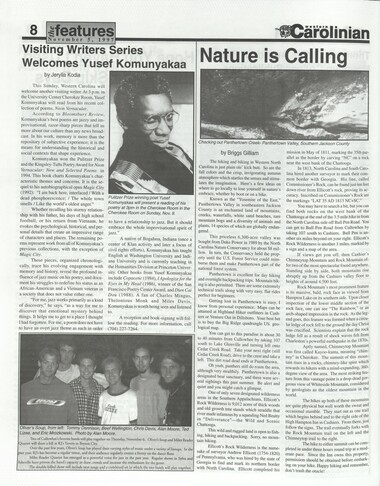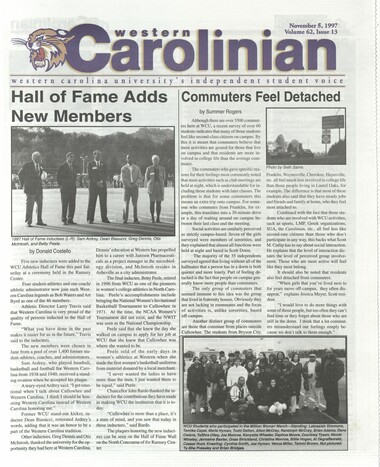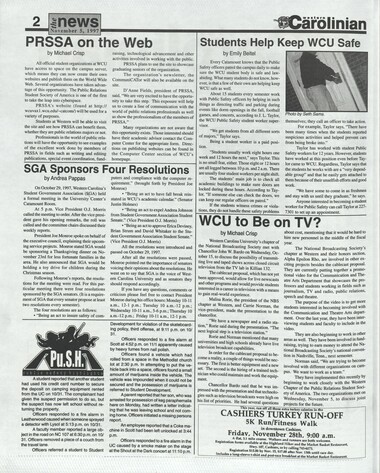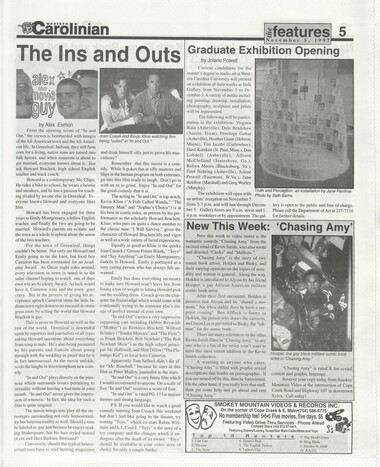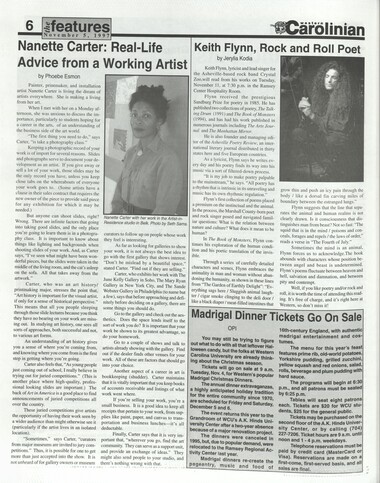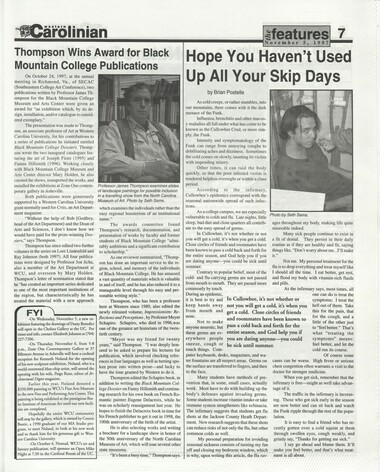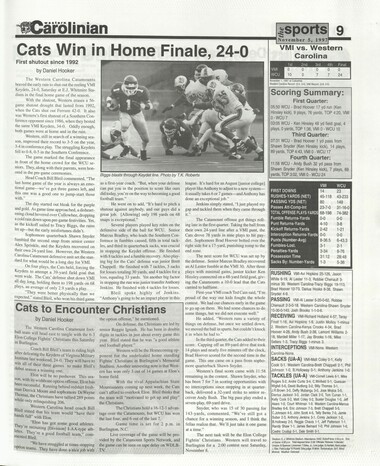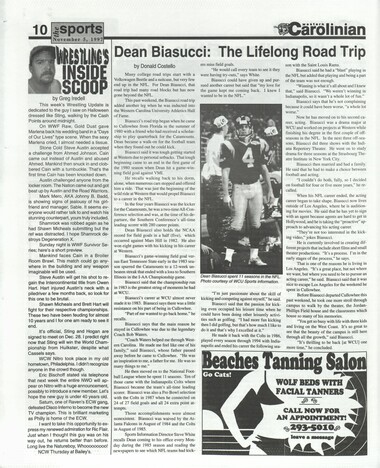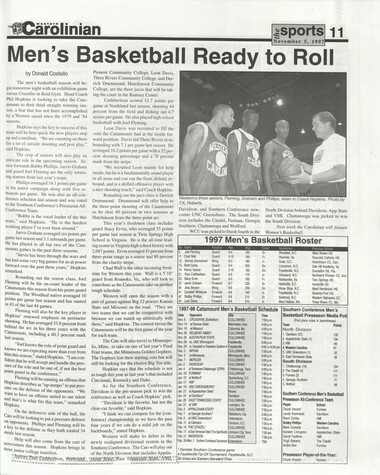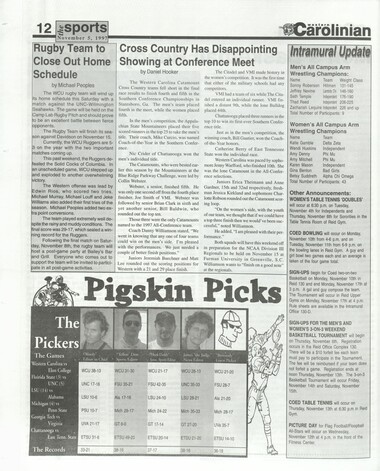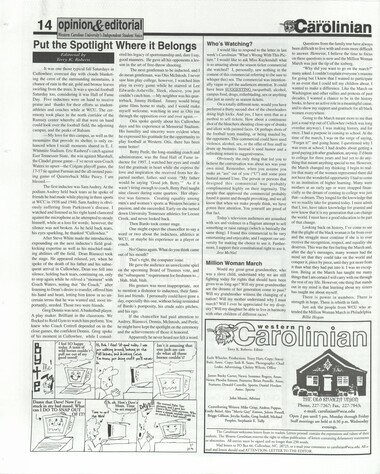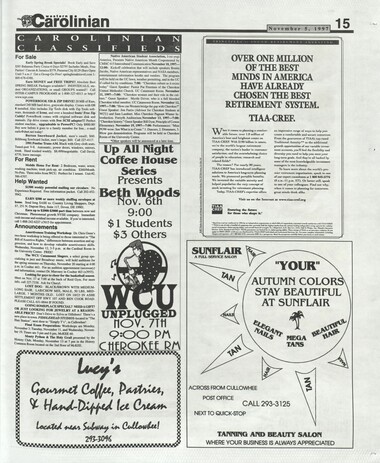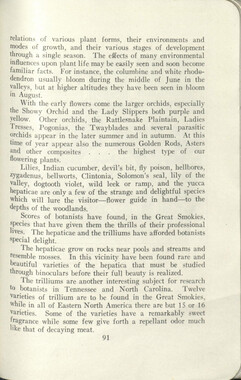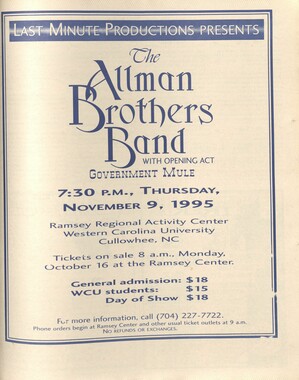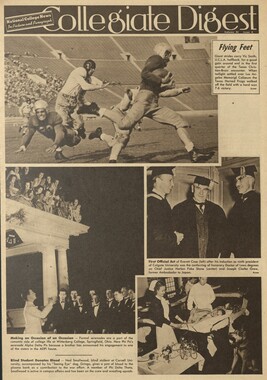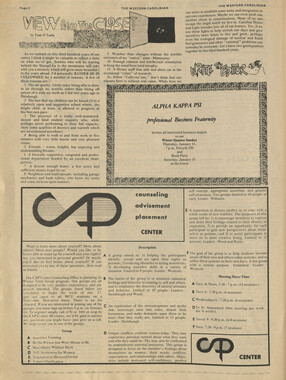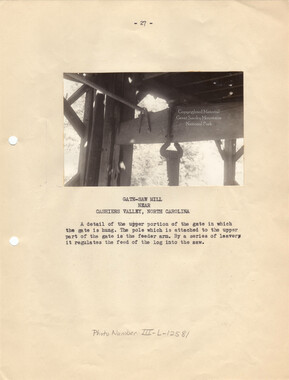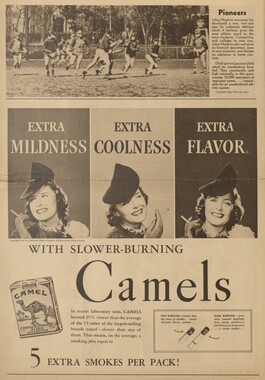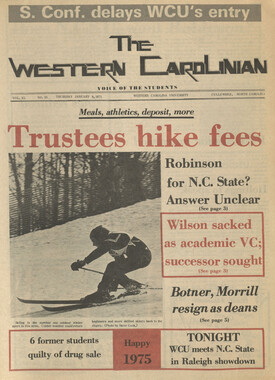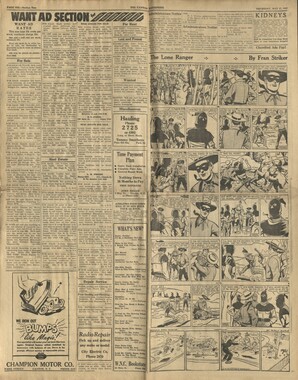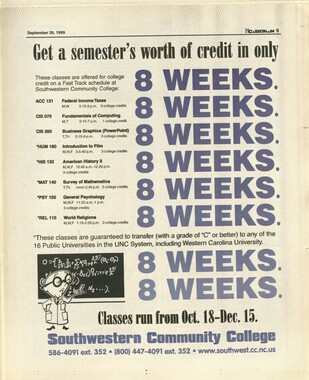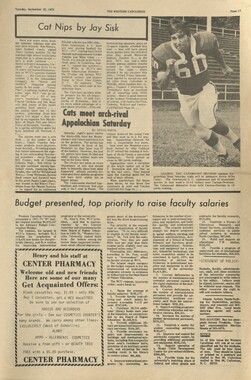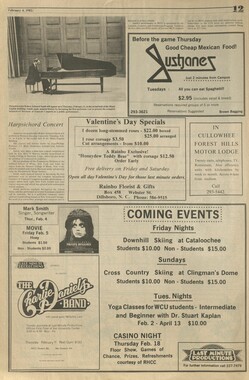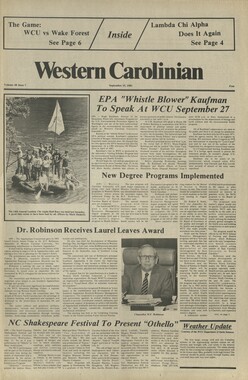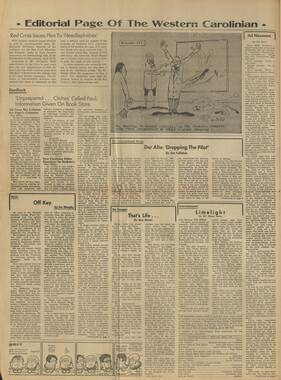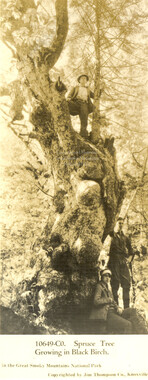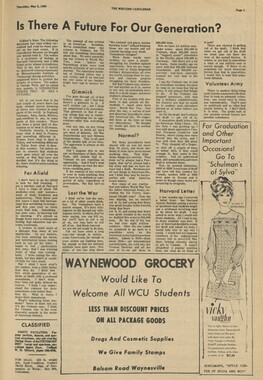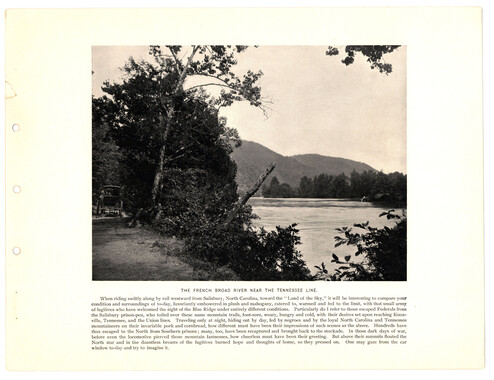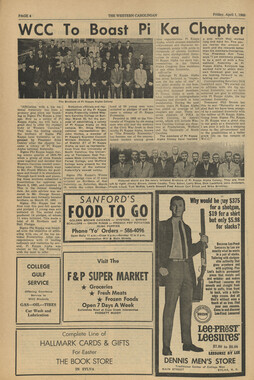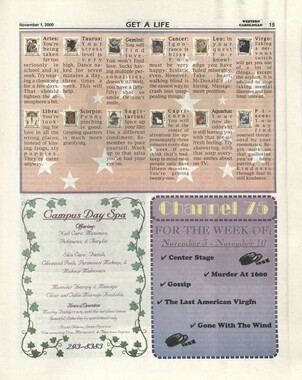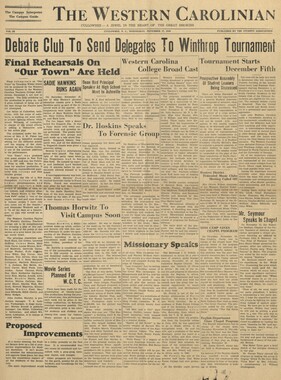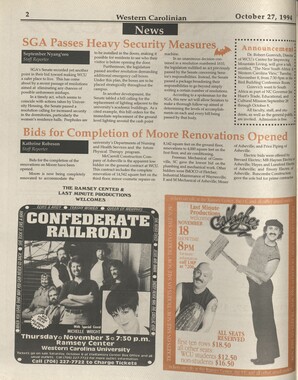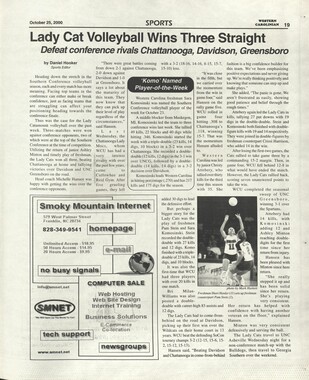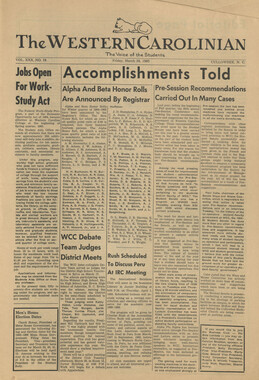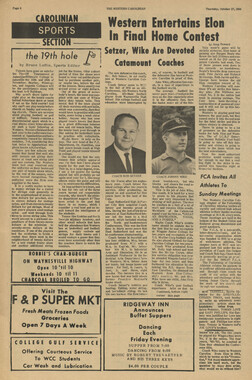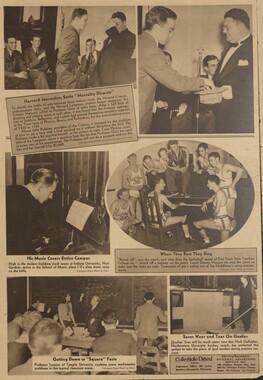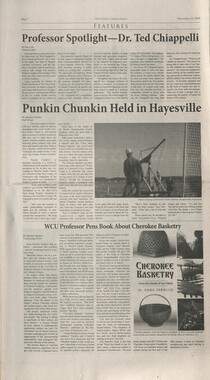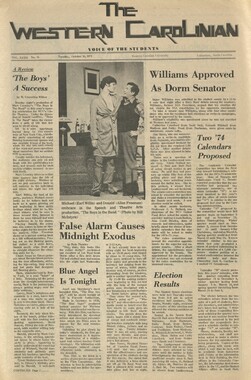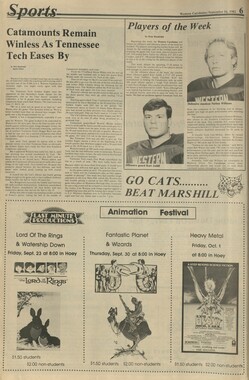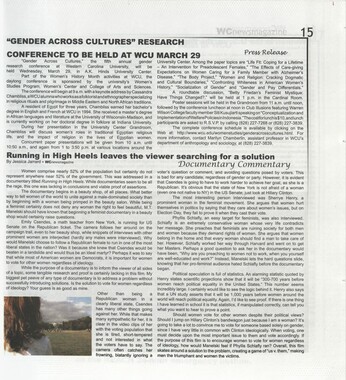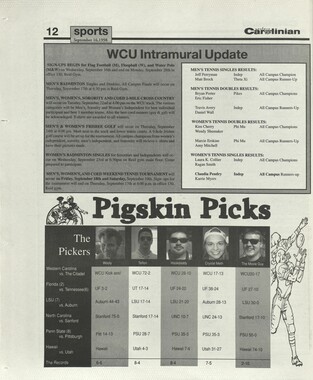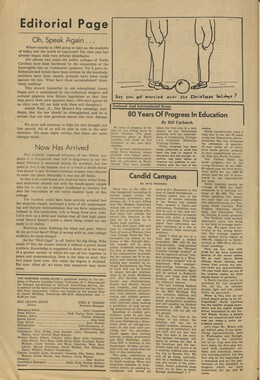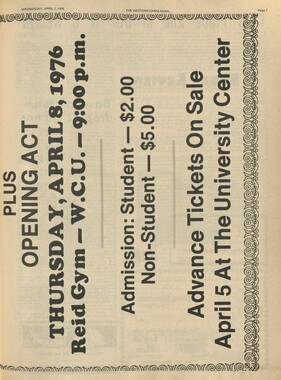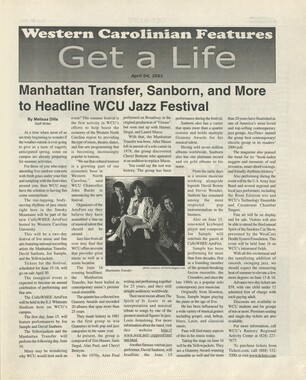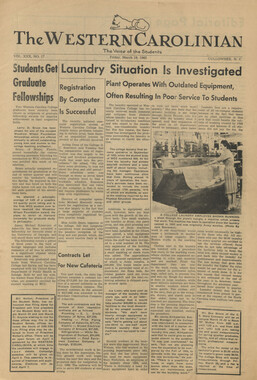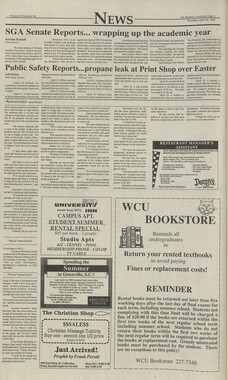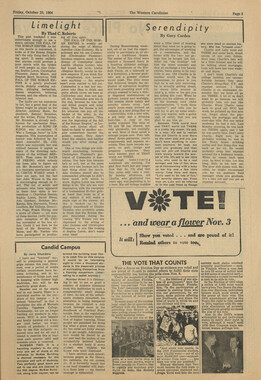Western Carolina University (21)
View all
- Canton Champion Fibre Company (2308)
- Cherokee Traditions (291)
- Civil War in Southern Appalachia (165)
- Craft Revival (1942)
- George Masa Collection (137)
- Great Smoky Mountains - A Park for America (3080)
- Highlights from Western Carolina University (422)
- Horace Kephart (973)
- Journeys Through Jackson (159)
- LGBTQIA+ Archive of Jackson County (89)
- Oral Histories of Western North Carolina (318)
- Picturing Appalachia (6617)
- Stories of Mountain Folk (413)
- Travel Western North Carolina (153)
- Western Carolina University Fine Art Museum Vitreograph Collection (129)
- Western Carolina University Herbarium (92)
- Western Carolina University: Making Memories (738)
- Western Carolina University Publications (2491)
- Western Carolina University Restricted Electronic Theses and Dissertations (146)
- Western North Carolina Regional Maps (71)
- World War II in Southern Appalachia (131)
University of North Carolina Asheville (6)
View all
- Allanstand Cottage Industries (62)
- Appalachian National Park Association (53)
- Bennett, Kelly, 1890-1974 (1463)
- Berry, Walter (76)
- Brasstown Carvers (40)
- Carver, George Washington, 1864?-1943 (26)
- Cathey, Joseph, 1803-1874 (1)
- Champion Fibre Company (233)
- Champion Paper and Fibre Company (297)
- Cherokee Indian Fair Association (16)
- Cherokee Language Program (22)
- Crowe, Amanda (40)
- Edmonston, Thomas Benton, 1842-1907 (7)
- Ensley, A. L. (Abraham Lincoln), 1865-1948 (275)
- Fromer, Irving Rhodes, 1913-1994 (70)
- George Butz (BFS 1907) (46)
- Goodrich, Frances Louisa (120)
- Grant, George Alexander, 1891-1964 (96)
- Heard, Marian Gladys (60)
- Kephart, Calvin, 1883-1969 (15)
- Kephart, Horace, 1862-1931 (313)
- Kephart, Laura, 1862-1954 (67)
- Laney, Gideon Thomas, 1889-1976 (439)
- Masa, George, 1881-1933 (61)
- McElhinney, William Julian, 1896-1953 (44)
- Niggli, Josephina, 1910-1983 (10)
- North Carolina Park Commission (105)
- Osborne, Kezia Stradley (9)
- Owens, Samuel Robert, 1918-1995 (11)
- Penland Weavers and Potters (36)
- Roberts, Vivienne (15)
- Roth, Albert, 1890-1974 (142)
- Schenck, Carl Alwin, 1868-1955 (1)
- Sherrill's Photography Studio (2565)
- Southern Highland Handicraft Guild (127)
- Southern Highlanders, Inc. (71)
- Stalcup, Jesse Bryson (46)
- Stearns, I. K. (213)
- Thompson, James Edward, 1880-1976 (226)
- United States. Indian Arts and Crafts Board (130)
- USFS (683)
- Vance, Zebulon Baird, 1830-1894 (1)
- Weaver, Zebulon, 1872-1948 (58)
- Western Carolina College (230)
- Western Carolina Teachers College (282)
- Western Carolina University (2008)
- Western Carolina University. Mountain Heritage Center (18)
- Whitman, Walt, 1819-1892 (10)
- Wilburn, Hiram Coleman, 1880-1967 (73)
- Williams, Isadora (3)
- Cain, Doreyl Ammons (0)
- Crittenden, Lorraine (0)
- Rhodes, Judy (0)
- Smith, Edward Clark (0)
- Appalachian Region, Southern (3032)
- Asheville (N.C.) (1945)
- Avery County (N.C.) (26)
- Blount County (Tenn.) (195)
- Buncombe County (N.C.) (1680)
- Cherokee County (N.C.) (283)
- Clay County (N.C.) (556)
- Graham County (N.C.) (238)
- Great Smoky Mountains National Park (N.C. and Tenn.) (525)
- Haywood County (N.C.) (3573)
- Henderson County (N.C.) (70)
- Jackson County (N.C.) (4925)
- Knox County (Tenn.) (35)
- Knoxville (Tenn.) (13)
- Lake Santeetlah (N.C.) (10)
- Macon County (N.C.) (421)
- Madison County (N.C.) (216)
- McDowell County (N.C.) (39)
- Mitchell County (N.C.) (135)
- Polk County (N.C.) (35)
- Qualla Boundary (982)
- Rutherford County (N.C.) (78)
- Swain County (N.C.) (2185)
- Transylvania County (N.C.) (270)
- Watauga County (N.C.) (12)
- Waynesville (N.C.) (86)
- Yancey County (N.C.) (72)
- Aerial Photographs (3)
- Aerial Views (60)
- Albums (books) (4)
- Articles (1)
- Artifacts (object Genre) (228)
- Bibliographies (1)
- Biography (general Genre) (2)
- Cards (information Artifacts) (38)
- Clippings (information Artifacts) (192)
- Copybooks (instructional Materials) (3)
- Crafts (art Genres) (622)
- Depictions (visual Works) (21)
- Design Drawings (1)
- Digital Moving Image Formats (2)
- Drawings (visual Works) (185)
- Envelopes (101)
- Exhibitions (events) (1)
- Facsimiles (reproductions) (1)
- Fiction (general Genre) (4)
- Financial Records (12)
- Fliers (printed Matter) (67)
- Glass Plate Negatives (381)
- Guidebooks (2)
- Internegatives (10)
- Interviews (823)
- Land Surveys (102)
- Letters (correspondence) (1045)
- Manuscripts (documents) (618)
- Maps (documents) (177)
- Memorandums (25)
- Minutes (administrative Records) (59)
- Negatives (photographs) (6090)
- Newsletters (1290)
- Newspapers (2)
- Notebooks (8)
- Occupation Currency (1)
- Paintings (visual Works) (1)
- Pen And Ink Drawings (1)
- Periodicals (194)
- Personal Narratives (10)
- Photographs (12977)
- Plans (maps) (1)
- Poetry (6)
- Portraits (4568)
- Postcards (329)
- Programs (documents) (181)
- Publications (documents) (2444)
- Questionnaires (65)
- Relief Prints (26)
- Sayings (literary Genre) (1)
- Scrapbooks (282)
- Sheet Music (2)
- Slides (photographs) (402)
- Songs (musical Compositions) (2)
- Sound Recordings (802)
- Specimens (92)
- Speeches (documents) (18)
- Tintypes (photographs) (8)
- Transcripts (329)
- Text Messages (0)
- A.L. Ensley Collection (275)
- Appalachian Industrial School Records (7)
- Appalachian National Park Association Records (336)
- Axley-Meroney Collection (2)
- Bayard Wootten Photograph Collection (20)
- Bethel Rural Community Organization Collection (7)
- Blumer Collection (5)
- C.W. Slagle Collection (20)
- Canton Area Historical Museum (2110)
- Carlos C. Campbell Collection (462)
- Cataloochee History Project (64)
- Cherokee Studies Collection (4)
- Daisy Dame Photograph Album (5)
- Daniel Boone VI Collection (1)
- Doris Ulmann Photograph Collection (112)
- Elizabeth H. Lasley Collection (1)
- Elizabeth Woolworth Szold Fleharty Collection (4)
- Frank Fry Collection (95)
- George Masa Collection (173)
- Gideon Laney Collection (452)
- Hazel Scarborough Collection (2)
- Hiram C. Wilburn Papers (28)
- Historic Photographs Collection (236)
- Horace Kephart Collection (861)
- Humbard Collection (33)
- Hunter and Weaver Families Collection (1)
- I. D. Blumenthal Collection (4)
- Isadora Williams Collection (4)
- Jesse Bryson Stalcup Collection (47)
- Jim Thompson Collection (224)
- John B. Battle Collection (7)
- John C. Campbell Folk School Records (80)
- John Parris Collection (6)
- Judaculla Rock project (2)
- Kelly Bennett Collection (1482)
- Love Family Papers (11)
- Major Wiley Parris Civil War Letters (3)
- Map Collection (12)
- McFee-Misemer Civil War Letters (34)
- Mountain Heritage Center Collection (4)
- Norburn - Robertson - Thomson Families Collection (44)
- Pauline Hood Collection (7)
- Pre-Guild Collection (2)
- Qualla Arts and Crafts Mutual Collection (12)
- R.A. Romanes Collection (681)
- Rosser H. Taylor Collection (1)
- Samuel Robert Owens Collection (94)
- Sara Madison Collection (144)
- Sherrill Studio Photo Collection (2558)
- Smoky Mountains Hiking Club Collection (616)
- Stories of Mountain Folk - Radio Programs (374)
- The Reporter, Western Carolina University (510)
- Venoy and Elizabeth Reed Collection (16)
- WCU Gender and Sexuality Oral History Project (36)
- WCU Mountain Heritage Center Oral Histories (25)
- WCU Oral History Collection - Mountain People, Mountain Lives (71)
- WCU Students Newspapers Collection (1923)
- Western North Carolina Tomorrow Black Oral History Project (69)
- William Williams Stringfield Collection (2)
- Zebulon Weaver Collection (109)
- African Americans (390)
- Appalachian Trail (35)
- Artisans (521)
- Cherokee art (84)
- Cherokee artists -- North Carolina (10)
- Cherokee language (21)
- Cherokee pottery (101)
- Cherokee women (208)
- Church buildings (190)
- Civilian Conservation Corps (U.S.) (111)
- College student newspapers and periodicals (2012)
- Dams (108)
- Dance (1023)
- Education (222)
- Floods (63)
- Folk music (1015)
- Forced removal, 1813-1903 (2)
- Forest conservation (220)
- Forests and forestry (1198)
- Gender nonconformity (4)
- Great Smoky Mountains National Park (N.C. and Tenn.) (181)
- Hunting (47)
- Landscape photography (25)
- Logging (122)
- Maps (83)
- Mines and mineral resources (9)
- North Carolina -- Maps (18)
- Paper industry (38)
- Postcards (255)
- Pottery (135)
- Railroad trains (72)
- Rural electrification -- North Carolina, Western (3)
- School integration -- Southern States (2)
- Segregation -- North Carolina, Western (5)
- Slavery (5)
- Sports (452)
- Storytelling (243)
- Waterfalls -- Great Smoky Mountains (N.C. and Tenn.) (66)
- Weaving -- Appalachian Region, Southern (280)
- Wood-carving -- Appalachian Region, Southern (328)
- World War, 1939-1945 (173)
Western Carolinian Volume 62 (63) Number 13
Item
Item’s are ‘child’ level descriptions to ‘parent’ objects, (e.g. one page of a whole book).
-
-
8 Ifeatures November 1997 western ■• • arolmian Visiting Writers Series Welcomes Yusef Komunyakaa by Jerylia Kodia This Sunday, Western Carolina will welcome another visiting writer. At 3 p.m. in the University Center Cherokee Room, Yusef Komunyakaa will read from his recent collection of poems, Neon Vernacular. According to Bloomsbury Review, Komunyakaa's best poems are jazzy and im- provisational, razor-sharp pieces that tell us more about our culture than any news broadcast. In his work, memory is more than the repository of subjective experience; it is the means for understanding the historical and social contexts that shape experience. Komunyakaa won the Pulitzer Prize and the Kingsley-Tufts Poetry Award for Neon Vernacular: New and Selected Poems in 1994. This book charts Komunyakaa's characteristic themes and concerns. It is the sequel to his autobiographical opus Magic City (1992): "I am back here, interfaced / With a dead phosphorescence; / The whole town smells / Like the world's oldest anger." Whether recalling his stormy relationship with his father, his days of high school football, or his return from Vietnam, he evokes the psychological, historical, and personal details that create an impressive range of characters and places. The remaining poems represent work from all of Komunyakaa's previous collections, with the exception of Magic City. These pieces, organized chronologically, trace his evolving engagement with memory and history, reveal the profound influence of jazz music on his poetry, and document his struggles to redefine his status as an African-American and a Vietnam veteran in a society that does not value either one. "For me, jazz works primarily as a kind of discovery," he says, "as a way for me to discover that emotional mystery behind things. It helps me to get to a place I thought I had forgotten. For me, a poem does not have to have an overt jazz theme as such in order Pulitzer Prize winning poet Yusef Komunyakaa will present a reading of his poetry at 3pm in the Cherokee Room in the Cherokee Room on Sunday, Nov. 9. to have a relationship to jazz. But it should embrace the whole improvisational spirit of jazz." A native of Bogalusa, Indiana (once a center of Klan activity and later a focus of civil rights efforts), Komunyakaa has taught English at Washington University and Indiana University and is currently teaching in the Humanities Division at Princeton University. Other books from Yusef Komunyakaa include Copacetic (1984), I Apologize for the Eyes in My Head (1986), winner of the San Francisco Poetry Center Award, and Dien Cai Dou (1988). A fan of Charles Mingus, Thelonious Monk and Miles Davis, Komunyakaa is worth being seen and listened to. A reception and book-signing will follow the reading. For more information, call (704) 227-7264. Oliver's Soup, from left: Tommy Dennison, Beef Wellington, Chris Davis, Alan Moore, Ted Lizee, and Eric Mrozkowski. Photo by Alan Moore. Two of Cullowhee's favorite bands will play together on Thursday, November 6. Olivers Soup and Miles Reader Quartet will share a bill at K) s Tavern in Bryson City. Over the past few years, Oliver's Soup has played their varying styles of music under a variety of lineups. In the past year, K] s has become a regular venue, and their audience regularly creates a frenzy on the dance floor. Miles Reader Quartet has emerged as a powerful voice for jazz in the past year. Regular shows in Sylva and (Asheville have proven the band's capacity to draw crowds and increase the enthusiasm for the genre. The double-billed show will include new songs and a combined set in which the two bands will play together. I i 'mill in f' in limn i i ii i i ii i i i ' I ni n in liniiiii 11 i i ' i i i M mi'ii , , Nature is Calling Checking out Panthertown Creek- Panthertown Valley, Southern Jackson County by Briggs Gilliam The hiking and biking in Western North Carolina is just plain ole' kick butt. So are the fall colors and the crisp, invigorating autumn atmosphere which startles the senses and stimulates the imagination. Here's a few ideas on where to go locally to lose yourself in nature's embrace, whether by boot or on a bike. Known as the "Yosemite of the East," Panthertown Valley in southeastern Jackson County is an enchanted land of mountains, creeks, waterfalls, white sand beaches, rare mountain bogs and a diversity of animals and plants, 14 species of which are globally endangered. This priceless 6,300-acre valley was bought from Duke Power in 1989 by the North Carolina Nature Conservancy for about $8 million. In turn, the Conservancy held the property until the U.S. Forest Service could reimburse them and make Panthertown part of the national forest system. Panthertown is excellent for day hiking and overnight backpacking trips. Mountain biking is also permitted. There are some extremely technical trails along with very easy, flat rides perfect for beginners. Getting lost in Panthertown is easy, I know from personal experience. Maps can be attained at Highland Hiker outfitters in Cashiers or Venture Out in Dillsboro. Your best bet is to buy the Big Ridge quadrangle US. geological map. You can get to this paradise in about 30 to 40 minutes from Cullowhee by taking 107 south to Lake Glenville and turning left onto Cedar Creek Road. Take your next right (still Cedar Creek Road), drive to the crest and take a left. This dirt road dead ends at Panthertown. Oh yeah, panthers still do roam the area, although very stealthily. Panthertown is also a designated bear sanctuary, and there were several sightings this past summer. Be alert and quiet and you might catch a glimpse. One of only seven designated wilderness areas in the Southern Appalachians, Ellicott's Rock Wilderness is 9,012 acres of thick woods and old growth tree stands which straddle that river made infamous by a squealing Ned Beatty in "Deliverance"—the Wild and Scenic Chattooga. This wild and rugged land is open to fishing, hiking and backpacking. Sorry, no mountain biking. Ellicott's Rock Wilderness is the namesake of surveyor Andrew Ellicott (1754-1820) of Pennsylvania, who was hired by the state of Georgia to find and mark its northern border with North Carolina. Ellicott completed his mission in May of 1811, marking the 35th parallel as the border by carving "NC" on a rock near the west bank of the Chattooga. In 1813, North Carolina and South Carolina hired another surveyor to mark their common border with Georgia. His line, called Commissioner's Rock, can be found just ten feet down river from Ellicott's rock, proving its accuracy. Inscribed on Commissioner's Rock are the markings "LAT 35 AD 1813 NC+SC." You may have to search a bit, but you can find both rocks on the west bank of the Chattooga at the end of the 3.5 mile hike in from the North Carolina side off Bull Pen Road. You can get to Bull Pen Road from Cullowhee by taking 107 south to Cashiers. Bull Pen is another six miles beyond on your right. Ellicott's Rock Wilderness is another 3 miles, marked by a sign and a map of the area. If views get you off, then Cashier's Chimneytop Mountain and Rock Mountain offer two of the most spectacular found anywhere. Standing side by side, both mountains rise abruptly up from the Cashiers valley floor to heights of around 4,500 feet. Rock Mountain's most prominent feature is its massive, bald, rock face as viewed from Hampton Lake on its southern side. Upon closer inspection of the lower middle section of the rock face, one can see "The Rainbow," or an arch-shaped impression in the rock. As the legend goes, this feature was formed when a circular ledge of rock fell to the ground the day Christ was crucified. Scientists explain that the rock ledge fell as a result of shock waves felt from Charleston's powerful earthquake in the 1870s. Aptly named, Chimneytop Mountain was first called Kayoo-kanta, meaning "chimney" in Cherokee. The summit of this mountain rises in a rocky, chimney-like spire which rewards its hikers with a mind-expanding, 360- degree view ofthe area. The most striking feature from this vantage point is a drop-dead gor- dered the geous view of Whiteside Mountain, consi by geologists as the oldest mountain in world. The hikes up both of these mountains are quite physical but well worth the sweat and occasional stumble. They start out as one trail which begins behind and to the right side ofthe High Hampton Inn in Cashiers. From there, just follow the signs. The trail eventually forks with the Rock Mountain trail on the left and the Chimneytop trail to the right. The hike to either summit can be completed in under three hours round trip at a moderate pace. Since the Inn owns this property, permission should be obtained before embarking on your hike. Happy hiking and remember, don't trash the oracle!
Object
Object’s are ‘parent’ level descriptions to ‘children’ items, (e.g. a book with pages).
-
The Western Carolinian is Western Carolina University's student-run newspaper. The paper was published as the Cullowhee Yodel from 1924 to 1931 before changing its name to The Western Carolinian in 1933.
-
